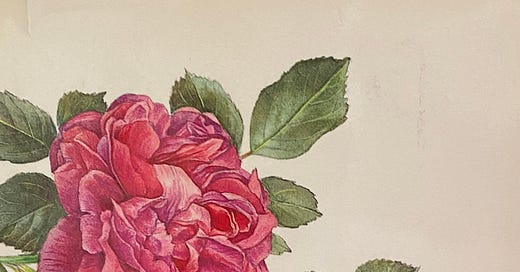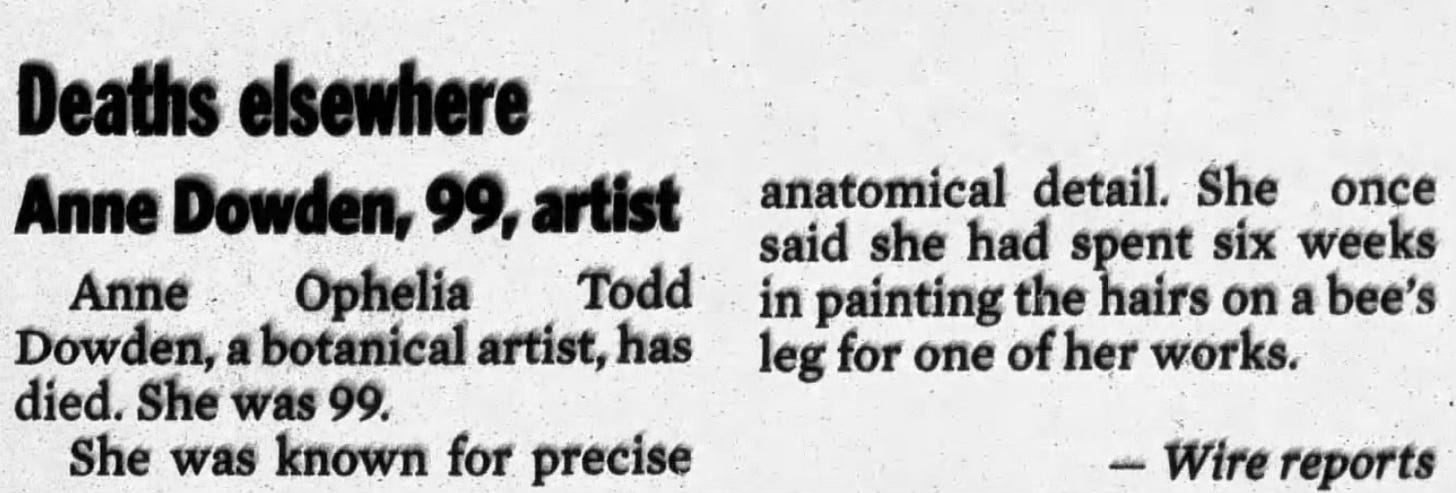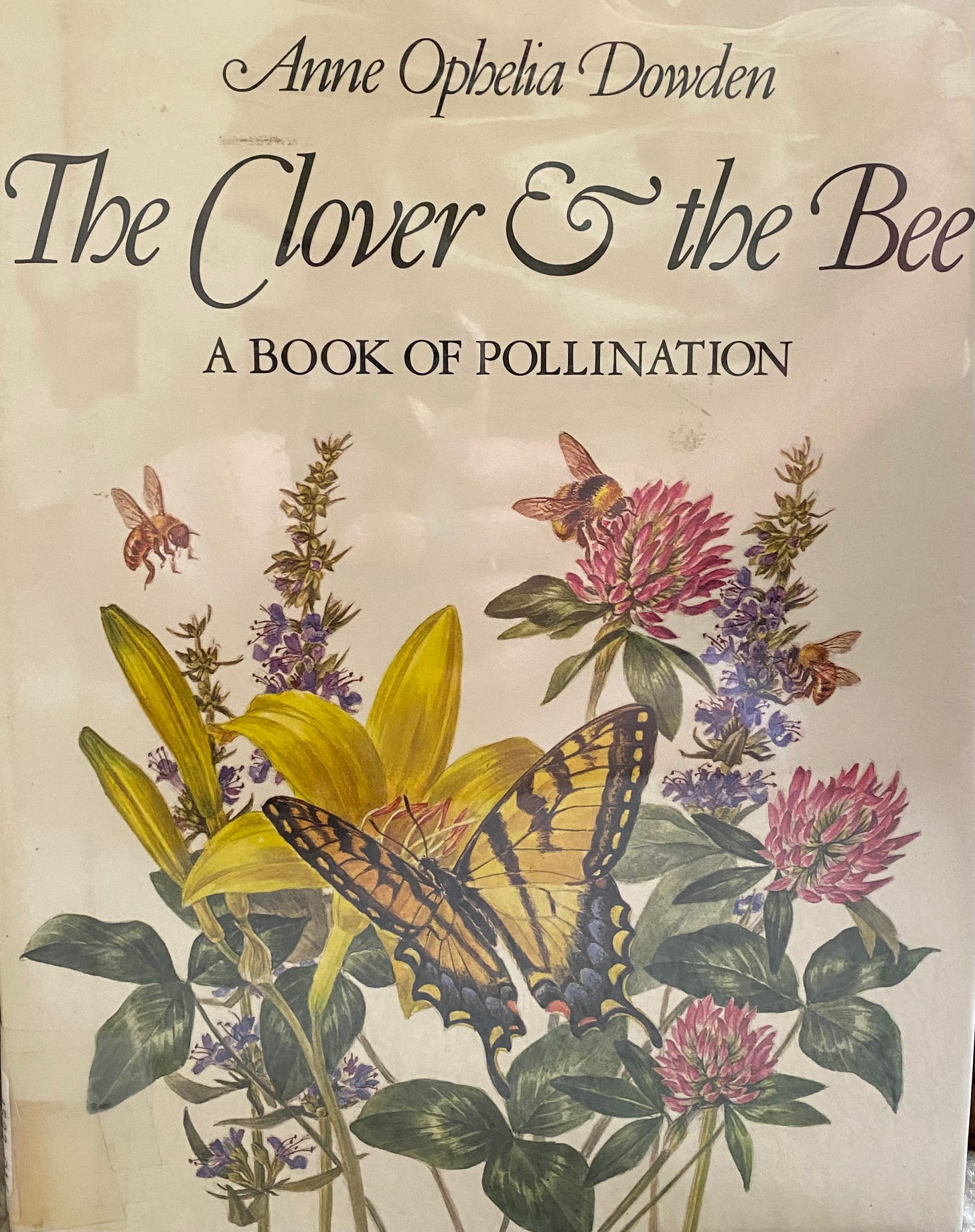In search of the next Lost Lady of Garden Writing to write about, I picked up a small, slim book, State Flowers, by Anne Ophelia Dowden (1978, Thomas Y. Crowell). On the cover, beneath the title, is the notation, “Illustrated by the Author.”
After reading her brief bio on the back flap of the cover and browsing State Flowers, I started doing some online searches and discovered Anne was not just an author. She was primarily known as a world-renowned botanical illustrator!
Her Biography
Anne’s life is well-documented in her obituary, published in the New York Times. She was born Anne Ophelia Todd on September 17, 1907, in Denver, Colorado, and grew up in Boulder. She roamed the Rocky Mountains' foothills at a young age, collecting and drawing nature specimens. Later, she also made medical drawings for her father, the head of pathology at the University of Colorado Medical School.
She studied art at the Carnegie Institute of Technology in Pittsburgh, obtaining her degree in 1930. She then moved to New York City and married Raymond Baxter Dowden, a fellow artist. He died in 1982. They had no children.
In 1990, she moved back to Boulder and lived there until her death on January 4, 2007. She was buried amongst other family members in Green Mountain Cemetery in Boulder. I found a YouTube video of a woman talking about Anne in the cemetery, if you want to hear more.
Her Life in New York City
Like many artists, Anne did not initially make her living from her artwork. According to her obituary in the New York Times, she was in her 40s when she began making a living from her artwork and in her 50s before she began writing and illustrating books.
As a young artist in New York, Ms. Dowden hoped to become a book illustrator, but met with little success. She supported herself for almost two decades by teaching at the Pratt Institute and then at Manhattanville College, where she founded the art department. She also designed floral printed wallpaper and drapery.
Ms. Dowden was in her late 40s when regular freelance illustration commissions for Life, House Beautiful, Natural History and other magazines enabled her to make the transition to full-time botanical illustration. She was in her 50s when she began publishing books. Her second, “Look at a Flower,” from 1963, remained in print for 22 years. Ms. Dowden returned to Boulder in 1990. Paintings from her last book, “Poisons in Our Path: Plants That Harm and Heal” (1994), were shown at the Denver Botanic Gardens in 2002. The same year, the Hunt Institute mounted a retrospective of her work to coincide with her 95th birthday. -
Illustrator or Author?
I was in a group of four other garden writers recently and asked if they had heard of Anne Ophelia Dowden. They had not. But perhaps if we had been a group of botanical illustrators, we would have known all about her. Per her obituary,
Her work was also shown in museums and at botanical gardens, including the Smithsonian, the New York Public Library and the Denver Art Museum. The Hunt Institute for Botanical Documentation at Carnegie-Mellon University in Pittsburgh holds a major body of her original artwork and most of her correspondence.
And
James White, curator of art and principal research scholar at the Hunt Institute, in a telephone interview, described Ms. Dowden as “surely among America’s leading botanical artists of the 20th century, and probably the most popular.”
Attention to Detail
In researching Anne and looking at her illustrations in my books, I was struck by her attention to detail. In one newspaper notification about her death, they noted that she once said she spent “six weeks in painting the hairs on a bee’s leg for one of her works.”
Her Books
Anne was both an illustrator and an author, and I feel fortunate to have found one of her books, State Flowers (1978), on one of my library shelves. After reading about her life and work, I found and purchased online two more books she wrote and illustrated: The Clover and the Bee: A Book of Pollination (1990) and This Noble Harvest: A Chronicle of Herbs (1979).
I also found and purchased four books illustrated by Anne but written by others: Plants of Christmas by Hal Borland (1969), The Golden Circle: A Book of Months by Hal Borland (1977), Consider the Lilies: Plants of the Bible by John & Katherine Paterson (1986), and Shakespeare’s Flowers by Jessica Kerr (1969).
For a more complete list of her books and an interesting article about Anne, check out this 1993 article in Mother Earth News. The article lists the 19 books she illustrated up to that time. I believe she illustrated 20 books in her lifetime.
Her Art
As noted in her obituary, much of Anne’s original artwork, plus her correspondence, is kept at the Hunt Institute for Botanical Documentation at Carnegie-Mellon Institute. (Check that link for additional biographical information.) There are also archives of some of her work kept in the University of Minnesota Archival Collection.
Intrigued?
I was unsure how to end this brief visit with Anne Ophelia Todd Dowden, perhaps because I don’t want to leave her just yet. I keep searching and finding more information, more anecdotes. So let us end with information about Anne from an article in the Henry County Local from New Castle, Kentucky, written November 5, 1970. It begins with Anne’s comment about goldenrod.
“Abundant it may be, but repugnant it is not.”
The article continues with Anne’s praise for goldenrod, which is the Kentucky state flower. Anne is even noted as suggesting it become the national flower since goldenrods of various species can be found nearly coast to coast. The article goes on to introduce Anne as an illustrator and author.
And that’s what I’ve attempted to do today. Introduce you to Anne as an illustrator and author. I hope you are as intrigued as I am.
Do you know about a Lost Lady of Garden Writing that I might find interesting? If so, please send me an email or leave a comment.
If you find these articles interesting and think others will too, please share them and/or subscribe.
I’ll return with the next Lost Lady of Garden Writing article in two weeks. In the meantime, you can find me in several places: my website and blog, The Gardenangelists podcast, and my weekly newsletter, In the Garden With Carol.







